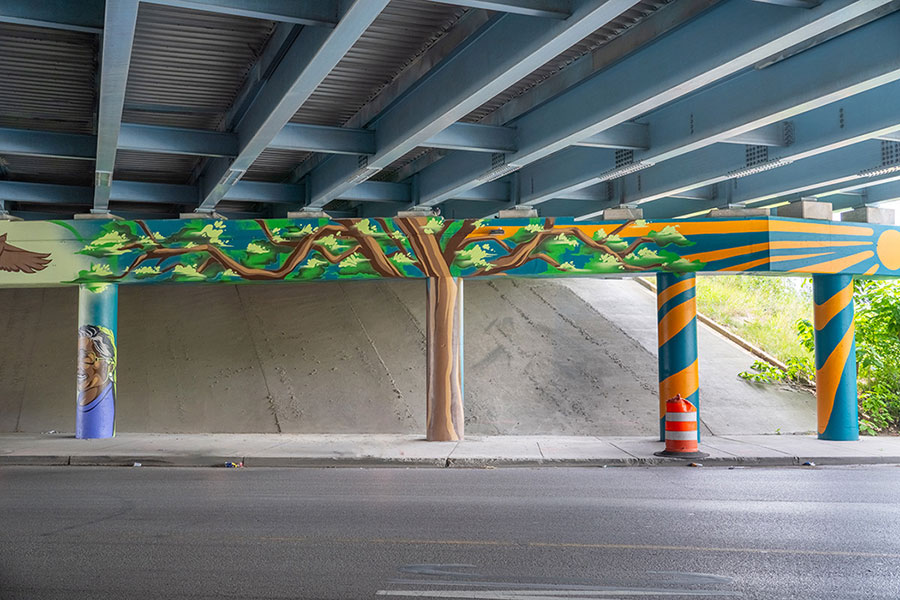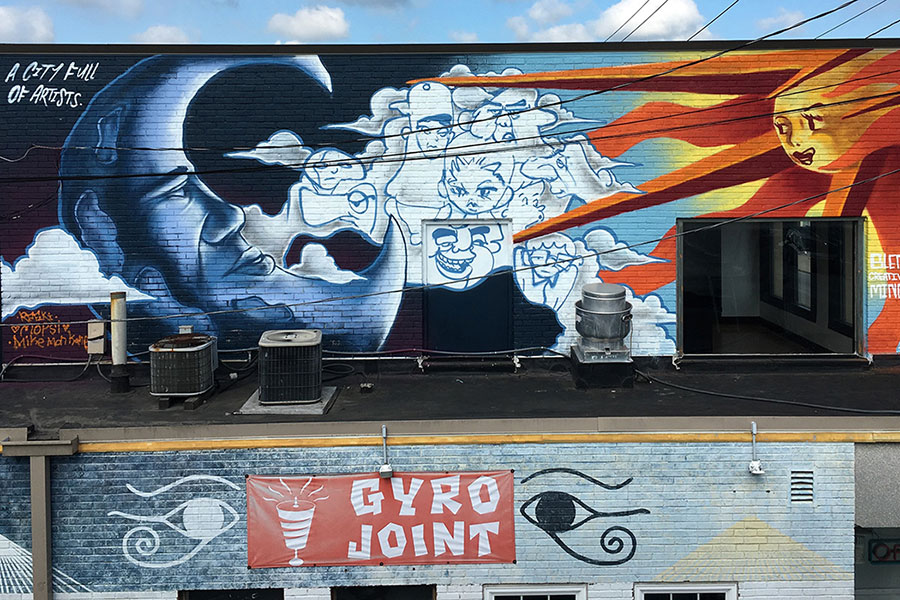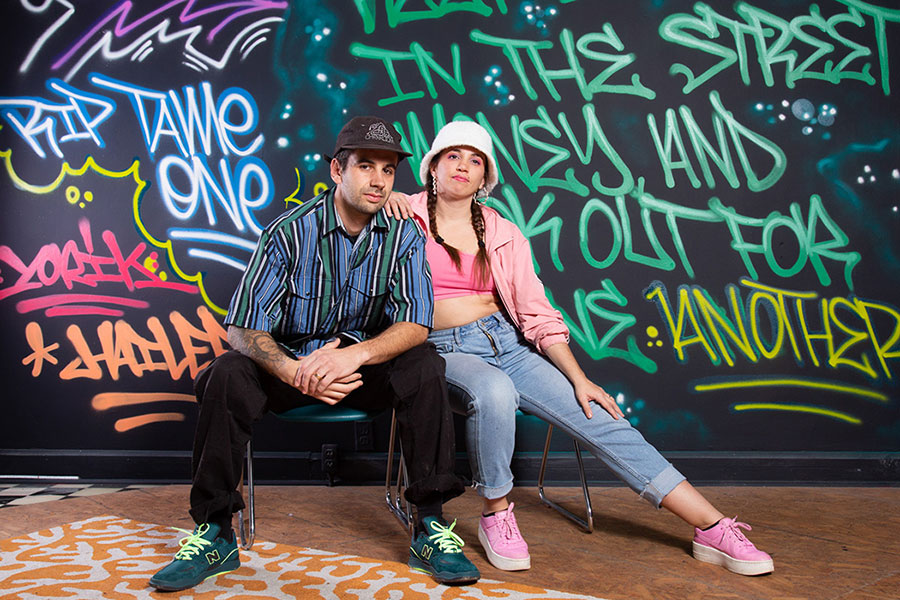For professional artists Rafael Caro, BFA’20, and Erica Parker, BFA’16, a single “canvas” typically covers several hundred square feet. It also may require a couple hundred cans of spray paint to complete their artwork! Together, Caro and Parker have created scores of graffiti-style murals throughout their Indianapolis home base and around the Midwest. They’ve also collaborated on community art events and immersive art installations.
Among their favorite joint projects? The City Full of Artists mural in Broad Ripple—a neighborhood in Indianapolis.
“There’s a sun and moon on one side and a cloud with all these different characters inside it,” Caro says. “It’s like all of the people in between—by day and by night—we’re creatives, you know?”
Both Caro and Parker graduated from IU Indianapolis’ Herron School of Art and Design. They founded their first arts collective in 2016, and, also romantically linked, the pair married in 2022.
One of Caro’s most ambitious personal projects to date includes a 14,000-plus-square-foot underpass mural for the I-65/I-70 North Split interchange. Caro responded to a call for artists, and nearby residents selected him. Still, before applying a single splash of paint, he spent five months tweaking his designs based on community feedback.

Once it is time to execute, the pair use industrial-grade paint sprayers for base coats and color gradients. Paint rollers are handy for blocking in big shapes. And for fine detail? Out come the specialty spray paints.
“The spray cans [developed for artists] have more pigment-to-base, so they have more color,” Caro says. “And they make different caps that you can put on the spray cans, so you can get a thin line, a fat line, a chisel tip…”
“You could get a super precision cap if you, for example, need to paint eyelashes,” Parker adds. “Or you could use an extra-wide cap if you're painting, like, a city building in your landscape.”
No matter what they’re working on, “Our goal is to show people how much thought and craft goes into painting with spray paint,” Parker says. “This material has the power to transform and beautify spaces.”
Keep reading for our expanded conversation with Caro and Parker.
How many murals have you completed together to date?
Rafael Caro: At least 20 [since] 2016. Dating back to the oldest, we did a lot of collaborations in Broad Ripple. We did a mural on a shed in OptiPark [in Broad Ripple]. That was some time ago.
Erica Parker: A lot of the collaborations that we do are live painting experiences. We got a grant from the Andy Warhol Foundation [in 2023], and we invested that in portable fencing that we can attach wood panels to and take anywhere across the city.
With graffiti, there is a difference between creating graphics versus tagging, correct? It’s a different mindset and there are different degrees of dimensionality and texture.
EP: I consider graffiti [to be] American folk art in a way because it was made here in the States. It’s like a true, raw form of artistic expression. And there’s a whole ecosystem within that medium—like a whole hierarchy or scale in the graffiti system. It starts at the bottom with tagging and then it progresses up to full pieces and productions.
RC: A lot of graffiti artists will actually turn into muralists. It kind of goes hand-in-hand, but also, they’re almost like contrasting, too. You can work big. You know how to use your wall. And there are elements of design within that, too, that you can pull from graffiti and correlate it to mural work.

What about the code of ethics around graffiti art that may or may not still be in play? Are some of the norms that used to exist still respected these days?
RC: The younger generations that are getting into graffiti don’t understand some of those codes of ethics, and then you’ll see them maybe vandalize a private property or [do] something really dumb. Not always, but sometimes we have the chance to redirect that and inform them. There’s a lot of legal places to do this stuff [in Indianapolis]. There’s a whole legal wall downtown where you can practice your art form.
What are some of your pie-in-the-sky dream projects? What would you love to do?
RC: [Erica is] really into the immersive art installation—where you can actually physically be in the art. We’ve done some of that and are leaning more in that direction. For me, my dream is a nice 100-foot-by-20-foot cinderblock wall and five people who come up with a really cool concept and then collaborate. We look at a lot of coffee table books of muralists doing that kind of thing and we call it a mural production.
Is a production mural executed in stages or in real-time all at once? How does that process work?
EP: It always starts at a roundtable. You invite your artist friends over for a sketch party and you just draw—you hang out and draw and talk about the content, but it’s really laid back, casual. And maybe you let those doodles marinate for a couple of days and you reconvene. Then, you start building the design together through these doodles. Once you get to the wall, it’s a very physically demanding process, and it takes days.
We do work fast, but it still takes days, because you’re putting a lot of thought into every aspect of this thing from the background to the foreground. But it’s really fun—just hanging out with people who love the same art form as you. The whole time you’re doing it, you’re learning from each other and building off of each other.

Do you have to put some kind of a protective coating over your outdoor murals?
EP: We like to do a clear coat on it, because, you know, anything can happen.
RC: Like with the underpass mural, there is a clear coat on there. Someone could go and pressure wash it without the paint flying off. And it also helps with vandalism, actually.
There was a quote in a February 2023 Pattern article that said, “We also all help each other with critiques. That’s something we learned through art school. It is constructive and it’s not all rainbows and sunshine, but it’s good and it’s helpful.” What are some things from your formal education that you find are applicable to your day-to-day work?
EP: Rafael majored in illustration. The entire motive of that major is to learn how to tell a story through your art specifically. That’s definitely an asset that we bring into our projects—really knowing how to convey a message rather than, ‘Okay, this is just a pretty picture.’
RC: Obviously, critiques help a lot, because you start to appreciate what other people see in your piece. Sometimes you’re not going to see something and having somebody else look at it with fresh eyes, that’s always good.”
Is there an overarching message or philosophy that permeates what you do?
EP: “Those who say, ‘It can’t be done,’ are getting in the way of those who can do it.” When I was visiting Venice Beach, Calif., I saw that on a mural. I was like, “That’s it! That’s how I have felt my whole artistic career.”
